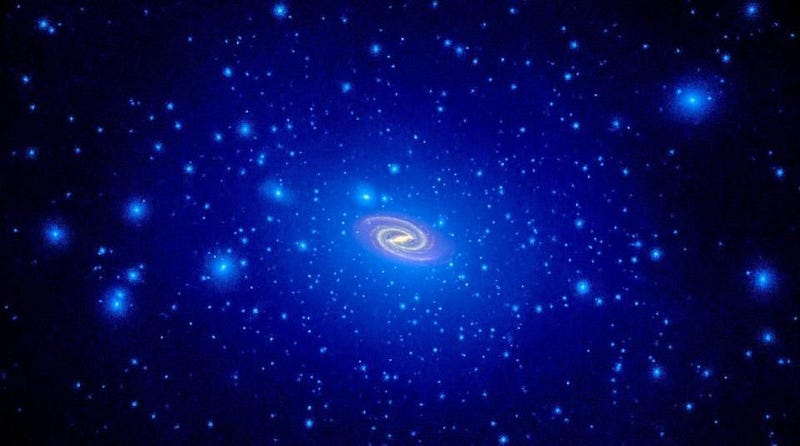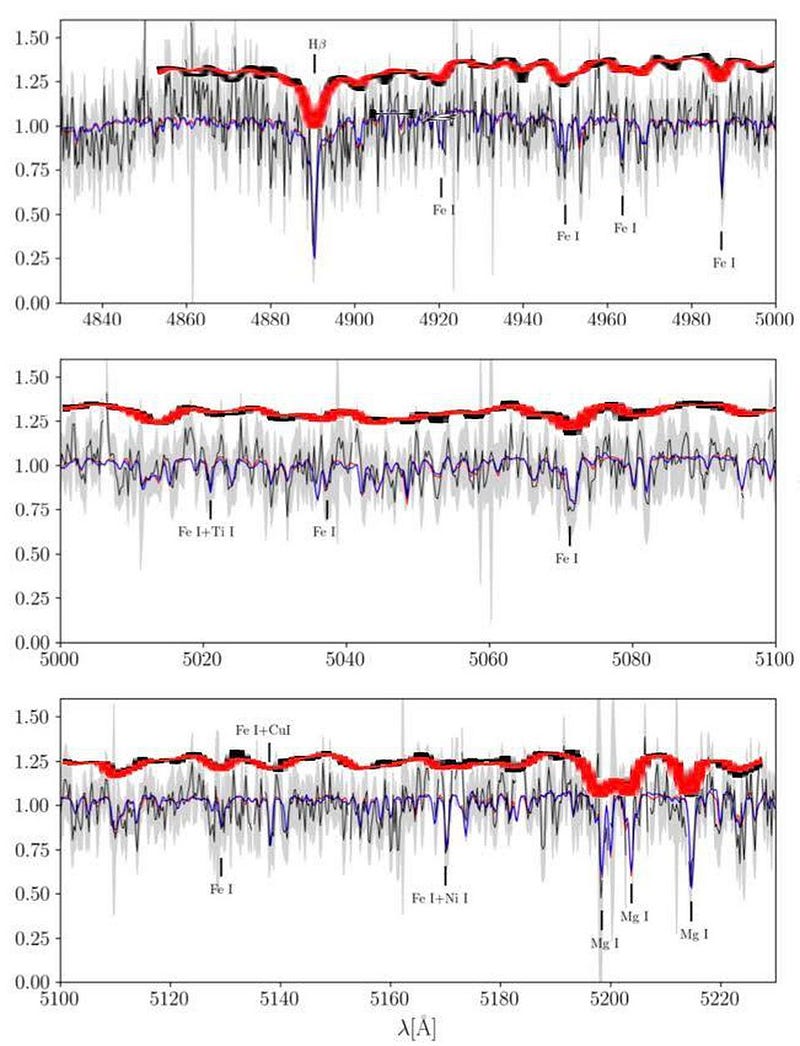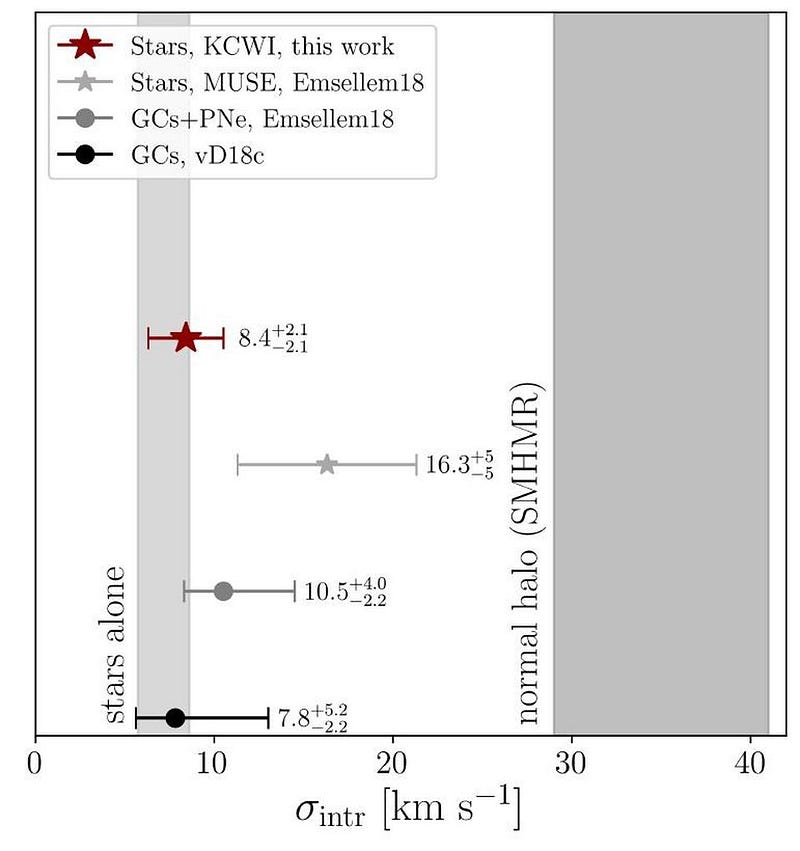Ask Ethan: What’s The Real Story Behind This Dark Matter-Free Galaxy?

Has the mystery really been solved? Doubtful. The real science goes much deeper.
For perhaps the last year or so, a small galaxy located not too far away has captivated the attention of astronomers. The galaxy NGC 1052-DF2, a satellite of the larger NGC 1052, appears to be the first galaxy ever discovered that shows no evidence of dark matter. Paradoxically, that has been reported as indisputable evidence that dark matter must exist! Now, a new team has come out with a result that claims this galaxy cannot be devoid of dark matter, and Yann Guidon wants to know what’s really going on, asking:
I read a study that said the mystery of a galaxy with no dark matter has been solved. But I thought that this anomalous galaxy was previously touted as evidence FOR dark matter? What’s really going on here, Ethan?
We have to be extremely careful here, and dissect the findings of the different teams with all the implications correctly synthesized. Let’s get started.

Whenever you have a galaxy in the Universe and you want to know how much mass is inside, you have two ways of approaching the problem. The first way is to rely on astronomy to give you the answer.
Astronomically, there are a slew of observations we can make to teach us about the matter content of a galaxy. We can look in a myriad of wavelengths of light to determine the total amount of starlight that’s present, and infer the amount of mass that’s present in stars. We can similarly make additional observations of gas, dust, and the absorption and emission of radiation in order to infer the total amount of normal matter that’s present. We’ve done this for enough galaxies for long enough that simply measuring some basic properties can lead us to infer the total baryonic (made of protons, neutrons, and electrons) matter within a galaxy.

On the other hand, there are additional gravitational measurements we can make that will teach us about the total amount of mass that’s present within a galaxy, irrespective of the type of matter (normal, baryonic matter or dark matter) that we see. By measuring the motions of the stars inside, either through direct line-broadening at different radii or through the velocity dispersion of the entire galaxy, we can get a specific value for the total mass. In addition, we can look at the velocity dispersion of the globular clusters orbiting a galaxy to obtain a second, complementary, independent measurement of total mass.
In most galaxies, the two values for the measured/inferred matter content differ by about a factor of 5-to-6, indicating the presence of substantial amounts of dark matter. But some galaxies are special.

From a theoretical perspective, we know how galaxies should form. We know that the Universe ought to start out governed by General Relativity, our law of gravity. It should have approximately a 5-to-1 mix of dark matter to normal matter, and should begin almost perfectly uniform, with underdense and overdense regions appearing at about the 1-part-in-30,000 level. Give the Universe time, and let it evolve, and you’ll form structures where the overdense regions were on small, medium and large scales, with vast cosmic voids forming between them, in the initially underdense regions.
In large galaxies, comparable to the Milky Way’s size or larger, very little is going to be capable of changing that dark matter to normal matter ratio. The total amount of gravity is generally going to be too great for any type of matter to escape, unless it speeds rapidly through a gas-rich medium capable of stripping the normal matter away.

But for smaller galaxies, there are interesting processes that can occur that are vitally important to this ratio of normal matter (which determines the astronomical properties) to dark matter (which, combined with the normal matter, determines the gravitational properties).
When most small, low-mass galaxies form, the act of forming stars is an act of violence against all the other matter inside. Ultraviolet radiation, stellar cataclysms (like supernovae), and stellar winds all heat up the normal matter. If the heating is severe enough and the mass of the galaxy is low enough, enormous quantities of normal matter (in the form of gas and plasma) can get ejected from the galaxy. As a result, many low-mass galaxies will exhibit dark matter to normal matter ratios far in excess of 5-to-1, with some of the lowest-mass galaxies achieving ratios of hundreds-to-1.

But there’s another process that can arise, on rare occasion, to produce galaxies with either very small or even, in theory, no amounts of dark matter. When larger galaxies merge together, they can produce an extreme phenomenon known as a starburst: where the entire galaxy becomes an enormous star-forming region.
The merger process, coupled with this star-formation, can impart enormous tidal forces and velocities to some of the normal matter that’s present. In theory, this could be powerful enough to rip substantial quantities of normal matter out of the main, merging galaxies, forming smaller galaxies that will have far less dark matter than the typical 5-to-1 dark matter-to-normal matter ratio. In some extreme cases, this might even create galaxies made of normal matter alone. Around large, dark matter-dominated galaxies, there might be smaller ones that are entirely dark matter-free.
A decade ago, there were a small number of scientists who claimed that the observed lack of these dark matter-free galaxies was a clear falsification of the dark matter paradigm. The overwhelming majority of scientists countered with claims that these galaxies should be rare, faint, and that it was no surprise we hadn’t observed them yet. With more data, better observations, and superior instrumentation and techniques, small galaxies with either small amounts of dark matter, or even none at all, ought to emerge.
Last year, a team of Yale researchers announced the discovery of the galaxy NGC 1052-DF2 (DF2 for short), a satellite galaxy of the large galaxy NGC 1052, that appeared to have no dark matter at all. When the scientists looked at the globular clusters orbiting DF2, they found the velocity dispersion was extremely small: at least a factor of 3 below the predicted speeds of ±30 km/s, which would have corresponded to this typical 5-to-1 ratio.

About 8 months later, another team, using a different instrument (rather than the unique Dragonfly instrument used by the Yale team), argued that the stars, rather than the globular clusters, should be used to determine the galaxy’s mass. Using their new data, they found an equivalent velocity dispersion of ±17 km/s, about twice as great as the Yale team had measured.
Undaunted, the Yale team made an even more precise measurement of the stars in DF2 using the upgraded KCWI instrument, and went back and measured the motions of the globular clusters orbiting it once again. With a superior instrument, they got a result with much smaller error bars, and both techniques agreed. From the stellar velocity dispersion, they got a value of ±8.4 km/s, with the globulars giving ±7.8 km/s. For the first time, it looked like we truly had found a dark matter-free galaxy.

But perhaps something was flawed. When scientists are truly engaging in good science, they’ll try to take any hypothesis, novel result, or unexpected find and poke holes in it. They’ll try to knock it down, discredit it, or find a fatal flaw with the result whenever possible. Only the most robust, well-scrutinized results will stand up and become accepted; controversies are at their hottest when a new result threatens to decide the issue once and for all.
The latest attempt to knock the DF2 results down come from a group at the Instituto de Astrofísica de Canarias (IAC) led by Ignacio Trujillo. Using a new measurement of DF2, his team claims that the galaxy is actually closer than previously thought: 42 million light-years instead of 64 million. This would mean it isn’t a satellite of NGC 1052 after all, but rather a galaxy some 22 million light-years closer, in the cosmic foreground.

This could change the story dramatically. The distance to a galaxy is extremely important to the intrinsic brightness you infer, which in turn tells you how much matter must be present in the form of stars. If the galaxy is much closer than previously thought, then there’s actually more mass present, and the inferred velocity dispersion will be higher, indicating the need for dark matter, after all.
Case closed, right?
Not even close. First off, DF2 isn’t the only galaxy that exhibits this effect anymore; there’s another satellite of NGC 1052 (known as DF4) that exhibits the same dark matter-free nature, so both would have to have their distances mis-estimated. Second, even if they are at the closer distance preferred by the Trujillo et al. team, that still renders DF2 and DF4 both extremely low-dark matter galaxies, which still necessitates a mechanism to separate normal matter from dark matter. And third, the Yale team had previously (in August) published a calibration-free distance measurement to the galaxy, from surface-brightness-fluctuations, inconsistent at 3.5 sigma with Trujillo’s results.

In other words, even if the distance estimates by Trujillo et al. are correct, which they probably aren’t, these galaxies are extremely low in dark matter, with DF4 possibly still even being dark matter-free. Neither team has yet observed this galaxy with the Hubble Space Telescope, but that will provide the most unambiguous distance estimate at all. Subsequent observations of DF4 with Hubble are slated for later in 2019, which should help clarify this ambiguity.
A short distance for these galaxies does not actually resolve the central issue: that they have much less dark matter, no matter how you massage it, than a naive, conventional dark matter-to-normal matter ratio would indicate. Only if dark matter is real, and experiences different physics in star-forming and collisional environments than normal matter, can galaxies like DF2 or DF4 exist at all.

The one takeaway, if you learn nothing else, is this: this new result resolves nothing. Stay tuned, because more and better data is coming. These galaxies are likely extremely low in dark matter, and possibly entirely free of dark matter. If the Yale team’s initial results hold up, these galaxies must be fundamentally different in composition from all the other galaxies we’ve ever found.
If all galaxies follow the same underlying rules, only their compositions can differ. The discovery of a dark matter-free galaxy, if that result holds up, is an extremely strong piece of evidence for a dark matter-rich Universe. Keep your eyes open for more news on DF2 and DF4, because this story is far from over.
Ethan Siegel is the author of Beyond the Galaxy and Treknology. You can pre-order his third book, currently in development: the Encyclopaedia Cosmologica.





